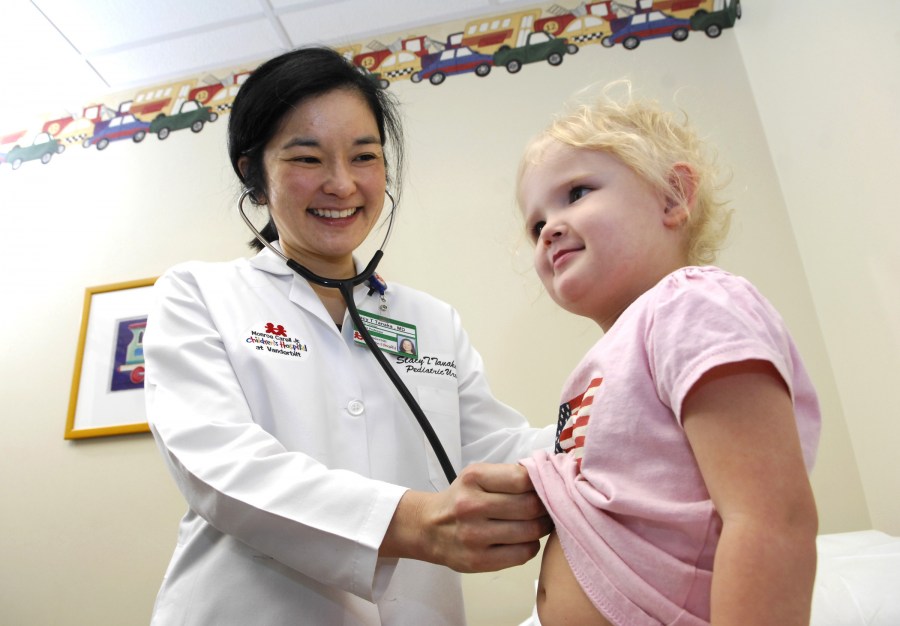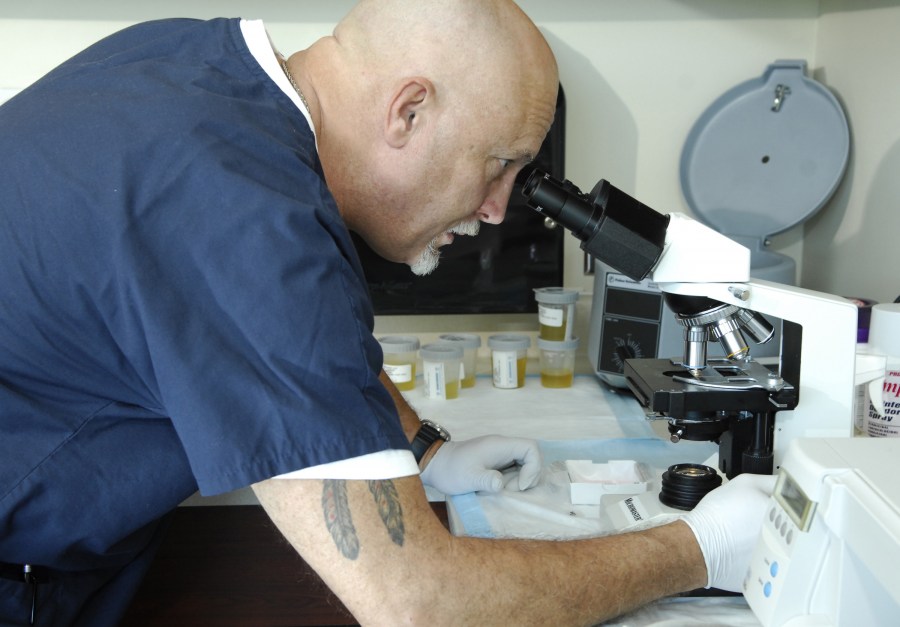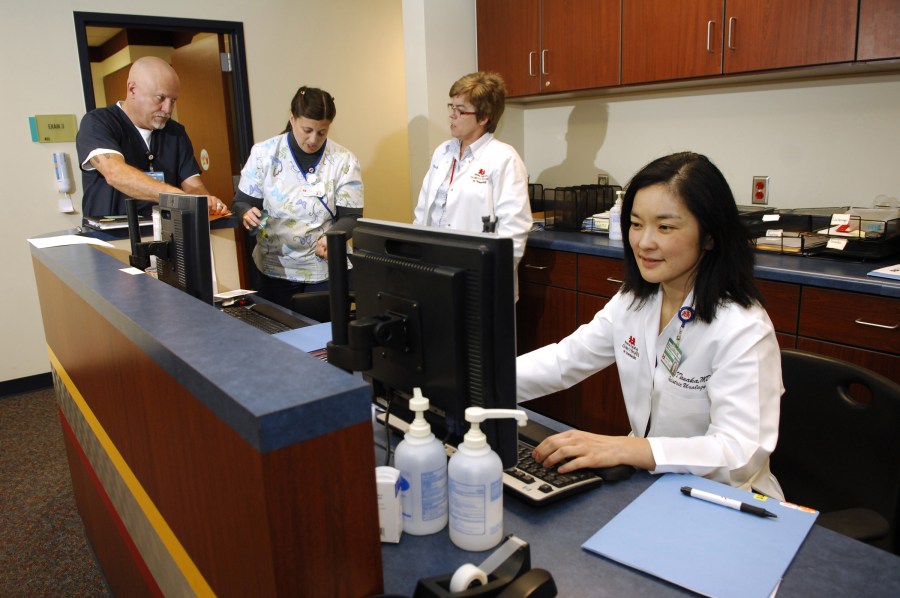
Stacy Tanaka, M.D., examines Natasha Cox, 3, in the Pediatric Urology Clinic at the Monroe Carell Jr. Children’s Hospital at Vanderbilt. (photo by Anne Rayner)
Teamwork, collaboration drive Pediatric Urology’s success
At least quarterly, doctors in the Division of Pediatric Urology gather in a small, dark room for a “difficult case conference.”
Like coaches going over game film, the group, led by division chief John W. Brock III, M.D., pores over projected images and video of their most perplexing cases. Physicians present the details to their peers, and the floor is officially open for suggestions on how to best treat the patients.
Whether the group is studying a bizarre bird’s nest of veins under a kidney to isolate the cause of a bleeding condition, or playfully ribbing newest staff member Douglass Clayton, M.D., in his first official week in clinic, the tone is more collaborative than competitive.
Moreover, the meeting is a glimpse into the team-oriented approach and camaraderie that have helped make the Pediatric Urology division at the Monroe Carell Jr. Children's Hospital at Vanderbilt one of the top programs in the country. U.S. News & World Report recently ranked the program fifth in the nation in its annual listing of “America's Best Children's Hospitals,” which is tops among pediatric specialty programs at Vanderbilt.
In short, Brock and his team say their recipe for success is always putting the patient first, and then creating a collaborative, “all-hands-on-deck” environment.
“Believe me,” says staff member John Thomas, M.D., assistant professor of Urologic Surgery, “I can have a ‘difficult case conference’ anytime by just walking into one of my colleagues’ offices and asking ‘what should I do here?’ The open-door policy is absolutely essential for the way that we practice.”

Jim Mitchell, LPN, processes lab samples at the Pediatric Urology Clinic. (photo by Anne Rayner)
The Pediatric Urology division at Children’s Hospital sees more than 14,000 children each year with problems associated with the genitalia or urinary tract (kidneys, ureters and the bladder). The team performs more than 2,200 surgeries a year, including innovative robotic surgeries, complex urologic reconstructions and a world-renowned in utero procedure to repair spina bifida.
There’s almost zero turnover within the department, with seasoned team members Brock, Mark Adams, M.D., and John Pope IV, M.D., totaling nearly a century’s worth of experience between them. A new, sought-after crop of surgeons, researchers and physicians like Clayton, Thomas and Stacy Tanaka, M.D., has also joined the ranks.
The division has expanded its care with specialty and off-site clinics to address bladder wellness, pediatric kidney stones, transition to adult care and spina bifida. The team has also been involved in opening a satellite surgical center in Guatemala to perform procedures for children in need.
Robert Mallard, M.D., a community physician for more than 30 years with nearby Heritage Medical Associates, says there’s no question where he sends his patients in need of specialty care. He says doctors and nurses in Children’s Hospital’s Pediatric Urology division go out of their way to see children promptly, and their follow-up is impeccable.
“I really do feel like we work as a team,” said Mallard. “It’s not like I’m sending my patients to Pediatric Urology and then dropping out. They immediately render opinions and communicate, and then we work together to do the best thing for the patients. They’re really a model of how clinical care should be done between the generalist and the specialty division.”
Mallard also lauds the department for its efforts to educate outside physicians on new urologic developments, whether they are happening at Vanderbilt or elsewhere in the country.
Teaching is a central theme within the department too, which is why the Pediatric Urology division’s research and clinical fellowship training program is widely considered one of best in the nation. The division funnels top-tier recruits to children’s hospitals across the country, making it its mission to train the next academic leaders in pediatric urology.
Fellows spend one year in clinic, and the other involved in research. And residents or fellows can always be seen by doctors’ sides during their surgeries or clinical duties.
Tanaka, assistant professor of Urologic Surgery and Pediatrics, completed her fellowship three years ago at Vanderbilt. She decided there wasn’t a better staff position for her anywhere else in the United States.
“I’ve been places where doctors didn’t see each other for weeks, which is definitely not the situation here,” she says. “You’re encouraged to find your niche, but there’s also a lot of crossover into other areas, which I think is unique.”
Tanaka, now a full-time staff member, splits her time between clinic and surgery and devotes at least three days a week to research, which is her specialty. Others keep similar schedules, and everyone makes a point to fill in for one another when needed.
The emphasis on research has paid off. In just a decade, the department has built an internationally recognized research component, earning numerous awards from the American Academy of Pediatrics and the Society of Pediatric Urology.

Teamwork is critical to the success of the Division of Pediatric Urology. Here, Stacy Tanaka, M.D., works with, from left, Jim Mitchell, LPN, Denise Todd, R.N., and Karen Brownlee, R.N., BSN, following a patient’s clinic visit. (photo by Anne Rayner)
With the help of a National Institutes of Health grant, the team has successfully identified genetic predispositions for congenital anomalies of the kidney and ureter tract. Recent findings have helped identify some causes of bladder disease, and researchers are now experimenting with treatments to minimize fibrosis, or scarring of the bladder.
“It’s exciting because I think ultimately our work will be translated into patient care,” says Pope, who oversees the division’s research arm. “That’s why we do research; to figure out a way to take better care of patients.”
Even the division’s research is based on collaboration, he says, noting recent partnerships with Vanderbilt’s Pediatric Nephrology and Adult Urology divisions.
“That’s the beauty of the Vanderbilt community,” Pope says. “You can walk down the hall and there’s a world expert who can help you troubleshoot and overcome obstacles. People really bend over backwards to help you in any way they can, not only in our division, but throughout the institution.”
As the lights are switched on and another difficult case conference comes to an end, the group explains the benefits of the exercise.
“Sometimes you can get a little bit of a bias that blinds you to conflicting information,” says Adams, professor of Pediatrics and Urologic Surgery. “It’s always helpful to have somebody else look at it to make sure that you’re not just trying to convince yourself that you’re right about what you’re seeing.”
Brock agrees.
“No one knows everything,” he says. “The strength of this program is the fact that we can lean on one another and ask questions in a non-threatening environment. Everyone has something to offer, whether he or she is young or old. The key is using the wealth of knowledge around us to improve what we do.”













